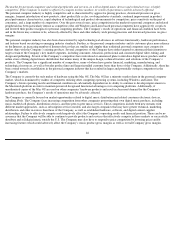Apple 2005 Annual Report Download - page 40
Download and view the complete annual report
Please find page 40 of the 2005 Apple annual report below. You can navigate through the pages in the report by either clicking on the pages listed below, or by using the keyword search tool below to find specific information within the annual report.
The Company orders components for its products and builds inventory in advance of product shipments. Because the Company’s markets are
volatile and subject to rapid technology and price changes, there is a risk the Company will forecast incorrectly and produce or order from
third-parties excess or insufficient inventories of particular products or components. The Company’s operating results and financial condition
in the past have been and may in the future be materially adversely affected by the Company’s ability to manage its inventory levels and
outstanding purchase commitments and to respond to short-term shifts in customer demand patterns.
Gross margin declined in 2004 to 27.3% of net sales from 27.5% of net sales in 2003. The Company’s gross margin during 2004 declined due
to an increase in mix towards lower margin iPod and iBook sales, pricing actions on certain Power Macintosh G5 models that were transitioned
during the beginning of 2004, higher warranty costs on certain portable Macintosh products, and higher freight and duty costs during 2004.
These unfavorable factors were partially offset by an increase in direct sales and a 39% year-over-
year increase in higher margin software sales.
Operating Expenses
Operating expenses for each of the last three fiscal years are as follows (in millions, except for percentages):
Research and Development (R&D)
The Company recognizes that focused investments in R&D are critical to its future growth and competitive position in the marketplace and are
directly related to timely development of new and enhanced products that are central to the Company’s core business strategy. The Company
has historically relied upon innovation to remain competitive. R&D expense amounted to approximately 4% of total net sales during 2005
down from 6% and 8% of total net sales in 2004 and 2003, respectively. This decrease is due to the significant increase of 68% in total net sales
of the Company for 2005. Although R&D expense decreased as a percentage of total net sales in 2005, actual expense for R&D in 2005
increased $45 million or 9% from 2004, which follows an $18 million or 4% increase in 2004 compared to 2003. The overall increase in R&D
expense relates primarily to increased headcount and support for new product development activities and the impact of employee salary
increases in 2005. R&D expense does not include capitalized software development costs of approximately $29.7 million related to the
development of Mac OS X Tiger during 2005; $4.5 million related to the development of Mac OS X Tiger and $2.3 million related to the
development of FileMaker Pro 7 in 2004; and $14.7 million related to the development of Mac OS X Panther in 2003. Further information
related to the Company’s capitalization of software development costs may be found in Part II, Item 8 of this Form 10-K at Note 1 of Notes to
Consolidated Financial Statements.
Selling, General, and Administrative Expense (SG&A)
Expenditures for SG&A increased $438 million or 31% during 2005 compared to 2004. These increases are due primarily to the Company’s
continued expansion of its Retail segment in both domestic and international markets, a current year increase in discretionary spending on
marketing and advertising, and higher direct and channel selling expenses resulting from the increase in net sales and employee salary
38
September 24,
September 25,
September 27,
2005
2004
2003
Research and development
$
534
$
489
$
471
Percentage of net sales
4
%
6
%
8
%
Selling, general, and administrative expenses
$
1,859
$
1,421
$
1,212
Percentage of net sales
13
%
17
%
20
%
Restructuring costs
$
—
$
23
$
26
























